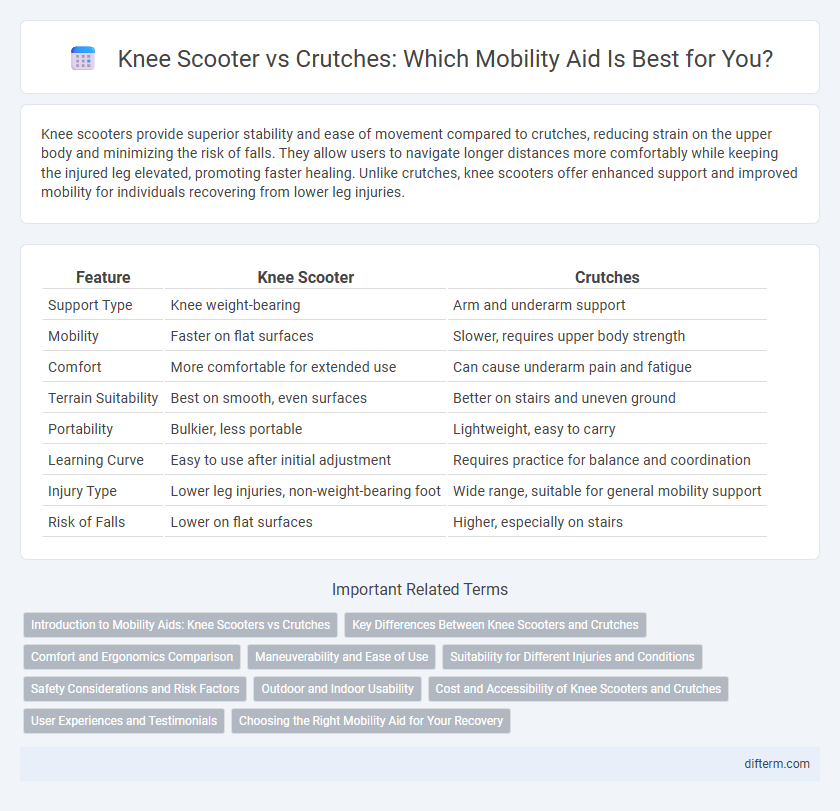Knee scooters provide superior stability and ease of movement compared to crutches, reducing strain on the upper body and minimizing the risk of falls. They allow users to navigate longer distances more comfortably while keeping the injured leg elevated, promoting faster healing. Unlike crutches, knee scooters offer enhanced support and improved mobility for individuals recovering from lower leg injuries.
Table of Comparison
| Feature | Knee Scooter | Crutches |
|---|---|---|
| Support Type | Knee weight-bearing | Arm and underarm support |
| Mobility | Faster on flat surfaces | Slower, requires upper body strength |
| Comfort | More comfortable for extended use | Can cause underarm pain and fatigue |
| Terrain Suitability | Best on smooth, even surfaces | Better on stairs and uneven ground |
| Portability | Bulkier, less portable | Lightweight, easy to carry |
| Learning Curve | Easy to use after initial adjustment | Requires practice for balance and coordination |
| Injury Type | Lower leg injuries, non-weight-bearing foot | Wide range, suitable for general mobility support |
| Risk of Falls | Lower on flat surfaces | Higher, especially on stairs |
Introduction to Mobility Aids: Knee Scooters vs Crutches
Knee scooters and crutches are common mobility aids designed to assist individuals with lower leg injuries or surgeries. Knee scooters provide greater stability and reduce upper body strain by allowing users to rest their knee on a padded platform and propel themselves with the uninjured leg. Crutches require upper body strength and coordination, often leading to fatigue and restricted mobility compared to the more comfortable and energy-efficient knee scooter.
Key Differences Between Knee Scooters and Crutches
Knee scooters provide enhanced stability and ease of movement by allowing users to rest their injured leg on a padded platform while propelling themselves with their uninjured leg, reducing upper body strain compared to crutches. Crutches require significant upper body strength and coordination as they support the entire body's weight through the arms, which can lead to fatigue and discomfort over prolonged use. Unlike crutches, knee scooters offer increased speed and maneuverability on flat surfaces but may be less suitable for navigating stairs or uneven terrain.
Comfort and Ergonomics Comparison
Knee scooters provide superior comfort by allowing users to rest their knee on a padded platform, reducing strain on the upper body compared to crutches. Ergonomically designed with adjustable height and swivel wheels, knee scooters enhance stability and ease of movement, minimizing muscle fatigue. In contrast, crutches often cause discomfort in the hands, wrists, and underarms, leading to potential nerve compression and poor posture over extended use.
Maneuverability and Ease of Use
Knee scooters offer superior maneuverability with smooth, stable wheels that navigate tight spaces and uneven surfaces effortlessly compared to crutches. Users experience enhanced ease of use, as knee scooters reduce strain on the upper body and require less balance and coordination. This makes knee scooters an ideal mobility aid for extended recovery periods or individuals with limited upper body strength.
Suitability for Different Injuries and Conditions
Knee scooters provide optimal support for lower leg, foot, and ankle injuries, allowing users to maintain mobility without bearing weight on the affected limb. Crutches are more versatile for a wider range of injuries, including those involving the knee or thigh, as they distribute weight through the hands and arms. Choosing between a knee scooter and crutches depends on the injury's location, the user's upper body strength, and the terrain where the mobility aid will be used.
Safety Considerations and Risk Factors
Knee scooters provide enhanced stability and reduce the risk of falls compared to traditional crutches, offering a safer alternative for individuals with lower leg injuries. Crutches demand significant upper body strength and balance, increasing the chances of muscle strain and accidental slips, particularly on uneven or slippery surfaces. Users of knee scooters benefit from less fatigue and improved maneuverability, which collectively minimize injury risks during mobility challenges.
Outdoor and Indoor Usability
Knee scooters provide superior outdoor usability due to their stability on uneven surfaces and ease of maneuvering, making them ideal for longer distances and rough terrain. Indoors, crutches offer greater versatility in tight spaces and stair navigation, allowing for easy movement through narrow hallways and compact rooms. Both mobility aids serve distinct purposes, with knee scooters excelling in outdoor comfort and crutches providing enhanced indoor accessibility.
Cost and Accessibility of Knee Scooters and Crutches
Knee scooters typically range from $70 to $200, offering a cost-effective alternative to crutches, which often cost between $20 and $50 but may require additional purchases like arm pads for comfort. Accessibility-wise, crutches provide greater portability and are easier to fit into tight spaces, making them suitable for quick trips, whereas knee scooters excel in indoor use with smooth surfaces but can be bulky and less convenient for stairs or uneven terrain. Both options vary in availability through medical supply stores, online retailers, and rental services, allowing users to choose based on budget and mobility needs.
User Experiences and Testimonials
Knee scooter users report increased mobility and reduced upper body strain compared to crutches, highlighting enhanced comfort during long-term recovery periods. Testimonials emphasize greater stability and ease in navigating various terrains, leading to improved daily activity levels and reduced fatigue. Many users note that knee scooters allow for faster rehabilitation with less pain, while some express concerns about bulkiness in tight spaces.
Choosing the Right Mobility Aid for Your Recovery
Selecting the right mobility aid depends on factors such as injury type, comfort, and ease of use; knee scooters provide enhanced stability and reduce upper body strain compared to crutches. Knee scooters allow faster, more comfortable mobility for lower leg injuries, while crutches offer greater maneuverability in tight spaces and stairs. Proper evaluation of recovery needs and environment ensures optimal support and speeds rehabilitation.
knee scooter vs crutches Infographic

 difterm.com
difterm.com